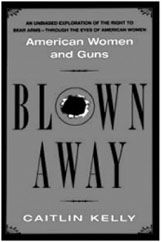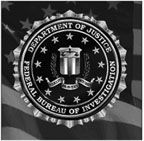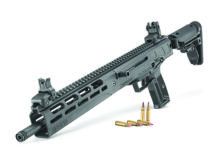Records Release: ATF Wont Supply Data on Illegal Firearms Use
Congress has stopped a federal agency from releasing records on guns used in crimes and may prevent their release in lawsuits against the gun industry as well.

The congressional ban on public releases of firearms-tracing data, placed in the current Bureau of Alcohol, Tobacco, Firearms and Explosives budget, has led the agency to conclude it cannot answer basic questions about gun crimes.
Because its information derived from licensed dealer records, we are prohibited from releasing that information, explained Gerald Petrilli, ATF chief in Denver. The ATF maintains a database of guns that have been stolen or used in suspected crimes, and it traces them back by serial numbers to the licensed firearms dealers who sold them.
Those data have been used by academic researchers, law-enforcement agencies, gun-control groups and media organizations to study the effectiveness of gun laws, identify guns favored by criminals, investigate patterns of gun trafficking and describe how mass killers armed themselves.
ATF records also have been employed in lawsuits accusing specific gun manufacturers and distributors of supplying weapons to criminals.
This year, Congress instructed the ATF not to disclose to the public any information collected from firearms dealers and held in agency databases.
Gun-control groups are battling the National Rifle Association and some law-enforcement agencies over a proposal to extend the data ban to lawsuits.
An amendment offered by Rep. Todd Tiahrt, a Kansas Republican, and adopted by the House states that ATF gun-tracing data and other dealer information shall not be subject to subpoena or other discovery in any civil action.
Tiahrt said he offered the measure at the behest of the ATF and the Fraternal Order of Police to protect officers investigating gun traffickers.
I was just thinking of the safety of police, he said. Some of these undercover officers have been involved in transactions that could be disclosed by the release of trace data.
Tiahrt said dissemination of ATF data also could endanger homeland security because information given to the general public about crime guns makes it available to criminals and terrorists as well.
Among those affected by the Tiahrt amendment is New York City, which has accused handgun manufacturers and distributors in a lawsuit of contributing to gun crimes.
On its website, the NRA warns that two sets of ATF computer records – multiple handgun purchase data and firearm trace data – is being sought in various reckless civil lawsuits against the firearms industry.
Kelly Hobbs, an NRA spokeswoman, said the Tiahrt amendment also is about protecting law enforcement and the privacy of gun owners.
Tiahrt said his efforts to protect ATF data were not intended to prevent the public from knowing about gun-store robberies. Theres a lot of things that Congress does that end up with unintended consequences, he said.
Our Take: The ATF data shouldnt be released to protect sensitive law-enforcement information and avoid exposing undercover officers involved in gun-trafficking investigations.
———-
Blown Away
“Blown Away: American Women and Guns” is a new book by Caitlin Kelly that examines the intersection of American women and firearms: recreational, political, economic, professional, cultural, social and criminal.

In particular, her interviews with women gun owners – delicately coifed elderly ladies, preppy Mount Holyoke College students, a big-game-hunting former Miss Mississippi – will ring true with many Gun Tests readers.
Kelly, a widely published newspaper and magazine journalist, initially chose to write about women and gun ownership when she learned two of her friends owned handguns. Both were white, middle-class women living in safe neighborhoods.
Kelly said, One had been abused as a child, and the other had lived in a dangerous neighborhood in Miami when she had small children and her husband was traveling often. In other words, they had both decided to acquire a gun for self-defense earlier in their lives, although both continued to own them after they no longer felt as endangered.
In 1996, she took a three-day defensive weapons class, during which 12 strangers stood beside her in a shooting range, learning a variety of skills designed to prepare them to shoot under high stress. She was fascinated by the perception that these skills were necessary; the diversity of age, income and perceived needs of her fellow participants; the complexity of learning to shoot well and safely; and the moral and ethical issues involved in deciding to shoot another human being.
Its a very American solution, wanting to be self-reliant and not have to turn to a man to save your life, she said.
She was also intrigued by the larger cultural and political context. Many women feel that feminism requires them to take care of themselves, but violence against women remains unabated. Women cant look to men for protection, yet theyre often demonized for taking a definitive step towards protecting themselves by acquiring a firearm.
She currently doesnt own a gun. I have shot a number of handguns and a few long guns, and enjoyed it, Kelly said. But owning a gun means assuming responsibility for storing it safely, cleaning and maintaining it, practicing with it often so you are completely confident with it. Right now, its more than Im ready for.
Researching the book proved more challenging than she expected because she encountered suspicion and hostility toward journalists from gun-owners.
She said, It took much longer to complete the research than Id planned as I had to persuade almost every gunowner that I was not automatically going to demonize them or attack their choice.
To find sources, she said, I put the word out to everyone I know, from fellow parishioners at my church to colleagues across the country. I also followed up with contacts from my 1996 shooting class at the Smith & Wesson Academy who introduced me to several law-enforcement subjects who would normally have been wary, if not inaccessible.
What, perhaps, was more difficult was selling the book. Twenty-five publishers rejected the proposal, 19 of them in 2000, the year after five school shootings, which made gun-related material repugnant to editors, she said. I sold the book shortly after 9/11, when anxiety about personal safety had, suddenly and nationally, risen significantly.
One of the surprising facts she learned about was a major national trend – teen shooting – that remains unexplored by traditional media. More than 110,000 teens are enrolled in courses offered by the 4-H clubs.
Our Take: Shooting is a fun, safe, and pleasant family activity. But you wont read about it in most magazines because the subject is controversial. Blown Away takes a small step toward dispelling some of the inaccurate opinions held by some nonshooters.
———-
New FBI NICS Procedure
Section 617 of the 2004 Consolidated Appropriations Bill, passed by Congress in January, dictates that the NICS (National Instant Criminal Background Check System) implement a 24-hour destruction period by July 21, 2004. This requires the destruction of all identifying information in the NICS Audit Log relating to a lawful purchase within 24 hours of delivering the proceed message to the FFL.

FFLs will no longer be able to contact the FBI NICS Section and reference a previously Proceeded NICS Transaction Number (NTN) to a current delayed NTN, on the same subject, to help expedite the final status on the delayed transaction. Within 24 hours after the FFL is notified of the Proceed status (by the start of the next business day at 8 a.m.), information will be purged from the system and the FBI NICS will only maintain non-identifying information on the Proceeded transaction. To get more information regarding the new 24-hour destruction policy, contact NICS Customer Service at (877) 444-6427.
Our Take: The FBI NICS will not have access to any of the buyers identifying information (name, social security number, miscellaneous numbers, etc.) after the FFL being notified of the Proceed status. This was an ongoing concern of many gun-rights and privacy-rights observers, so were glad this change has been implemented.
———-
Safety Strategy for Hunters
The 2000 annual report of Hunting and Hunting-Related Incidents (the most recent available) identifies poor judgment relating to visibility as the leading contributor of hunting-related incidents during that year. The report, as published on the International Hunter Education Association website, indicates that there were 630 two-party injuries and 65 fatalities in 2000.
Though Gun Tests hunting-gear focus is on rifles, shotguns, ammunition, and optics, we recognize safety is a prime concern, since many injuries occur because of gun accidents or misuse. One of the biggest problems is hunters being mistaken for game, and getting shot because of it.
State laws across the country require hunters to wear hunter-orange clothing while participating in the sport. Unfortunately, wearing blaze orange is not always enough. Of the 630 hunting accidents in 2000, more than 35 percent of those injured or killed were wearing blaze orange. Hunters must realize that wearing blaze orange clothing does not guarantee they will be identified as a fellow hunter, and not mistaken for game, says Walter Kaihatu, vice president of sales and marketing for Streamlight, Inc.
To improve safety, hunters should carry and use a flashlight designed for the outdoors. LEDs are the latest in lighting technology, and flashlights equipped with green LEDs are highly recommended. However, green LEDs are less likely than high-intensity white lights to scare game or affect night vision.
Our Take: Weve tested three units from Streamlight: the Stylus, Green Trident, and ClipMate LED products. On public land, we would definitely like to have a light identifying us as humans, since deer rarely carry flashlights – they dont have pockets.
———-
Minnesota Judge Rules Against Carry Law
A Minnesota judges ruling in July may put the states carry law at risk. The ruling by Ramsey County District Judge John Finley focused on how lawmakers actually passed the states handgun bill.
By large margins, the House twice passed an NRA-backed handgun bill that failed on a tie vote in the Senate, then was denied another floor vote by Senate leaders. House leaders responded by attaching a minor bridge amendment to a Department of Natural Resources measure dealing with certified rifle safety training for hunters. Then came 26 pages of handgun revisions that dwarfed the original 10-page bill.
With the bridge amendment in place, the move withstood a germaneness challenge on the floor, a parliamentary safeguard against amendments that have nothing to do with the bill being debated.
All of this was strategy to force an up-or-down Senate vote on the measure. Under legislative rules, senators could only concur with or reject the House amendments. After seven hours of debate they voted 37 to 30 to concur. Hours later, Gov. Tim Pawlenty signed the bill into law.
In his ruling, Finley said the handgun language is totally unrelated to the original bill. He also noted that the bills official title, an act relating to natural resources, was not changed in any of the legislative maneuvering. The reviser of statutes later changed it to an act relating to state government regulation without legislative approval, Finley said.
This law is unconstitutional because it clearly violates not only the intent, but also the clear meaning of the state Constitutions requirement of single-subject legislation, Finley wrote.
Attorney General Mike Hatch has said he will appeal the ruling, beginning with seeking a stay of its effect while the appeal is pending.
The law makes handgun permits available to practically any adult who gets the required training and passes a criminal and mental health background check.
Our Take: Permits issued under the law remain valid, but new ones would be subject to the more restrictive former law that gave sheriffs and police chiefs broad discretion to grant or deny them. Most likely, Finleys ruling will be overturned on appeal.
———-
SIG Sauer Pistols For Less
In many previous tests, SIG Sauer pistols have gotten Buy It or Our Pick recommendations, but a quick search of Gun Tests back issues didnt show a one of the companys pistols getting a Best Buy recommendation. Reason: The guns are usually expensive.
Possible solution: SIG Sauer is offering certified pre-owned pistols through dealers nationwide. These pistols are trade-ins from law enforcement agencies, or in the companys parlance, theyre duty tested. Then, Sigarms armorers put each gun through a factory certification to ensure each pistol is reliable. Each gun carries a one-year factory warranty.
The factory certification means the gun is field-stripped, refitted with original factory parts where needed, cleaned and lubricated, function tested and and hand-inspected.
Each pistol is packaged in a lockable pistol case. Included in the case will be an owners manual stamped PRE-OWNED in red, a cable lock, and two standard-capacity magazines. These pistols ship with a blue grip band identifying them as certified pre-owned guns. The condition of these used pistols will vary depending on the amount of wear, such as that caused by a holster or rings. Pistols that have shown excessive wear on the slide will often have the slide refinished in a Nitron finish.
The exclusive distributor for the program is Interstate Arms, www.interstatearms.com, (978) 667-7060.
Our Take: Buying any used gun is something of a risk, but this looks like a good way to buy a topnotch product at a reasonable price. Most of the guns sell for only $429 dealer cost. Well investigate further and let you know what we find.






























